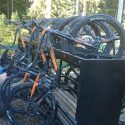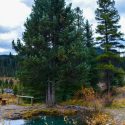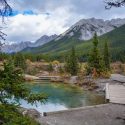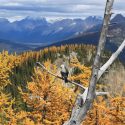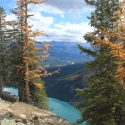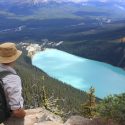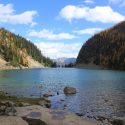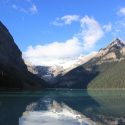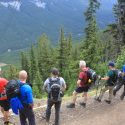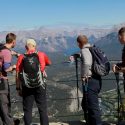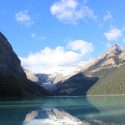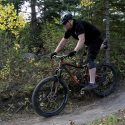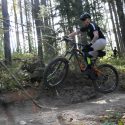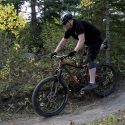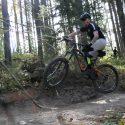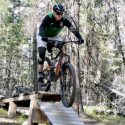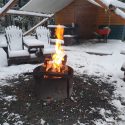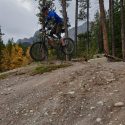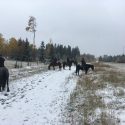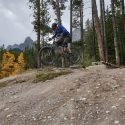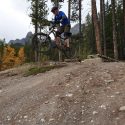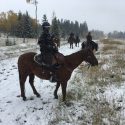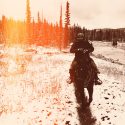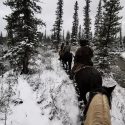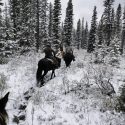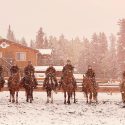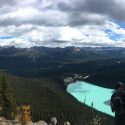The Concept:
In October 2018, the Regimental Administration Officer (RAO) for Northern Ireland Garrison Support Unit, Major J Swanson MBE, aspired to organise an Adventurous Training (AT) package to the Rocky Mountains, Alberta, Canada. His aim was to promote cohesion and develop the soldiers within the unit through level 3 AT training.
For an expedition of this magnitude, considerable funds would be needed and he approached every source possible to acquire the necessary funding. By May 2019 he knew he had what was needed and the concept would become a reality: EX FINN KANATA, commencing 19 September 2019, was born.
The Build up Training:
In the months prior to deployment, meetings were held to determine who would be selected to attend the exercise. During this process it was highlighted that the time on exercise was short and build up training would alleviate – to a degree – having to learn on task. With Major Swanson and his chief instructor conducting reconnaissance on the location, the second instructor organised several days of mountain biking around Northern Ireland while the stables at Thiepval Barracks hosted horse riding sessions. For a fortunate few, there were some slots available to attend the Mountain Bike Foundation course at the Joint Service Adventurous Training Centre (JSATC), Ballykinler.
The Deployment:
The seven hour flight to Calgary Airport from Dublin was long and tiring, but no rest was earned as the troops were picked up by the advanced party and driven to Trails End Camp (TEC) ready to begin the exercise. TEC, rented by the British Army, supplied the equipment required for the hiking and horse riding phases. The accommodation and messing facilities of TEC are owned and supplied by the Lazy H ranch, though the chefs were Army: the food was fantastic.
The multi-man room of bunk beds would be the troops’ home for the next two weeks.
The Main theme:
The fourteen members were split into two equal groups, where they alternated hiking and mountain biking. The daily routine was breakfast at 0630 and in the van thereafter; to return by 1800 each day for dinner, when the daily blog was to be written by the selected troops and submitted to the Unit by 2100 local.
Hiking:
Sergeant Trevor McWhirter (R IRISH) was the instructor leading the troops for this aspect of the Adventure Training expedition. Using his knowledge of the region, he planned routes covering Sulphur Mountain and Lake Louise – leading to Mirror Lake and Big Beehive Mountain, traversing over the six glaciers, and on to Johnston’s Canyon and the Ink Pots.
Each of the three days saw the troops experiencing differing aspects of the Rocky Mountains. Spectacular views over the valley, that stretched beyond the imagination, contrasted with azure blue lakes, and framed by mountains covered in lush green pine trees reaching up to snow capped peaks. Immense crystal glaciers, slowly and silently cutting through the rock towards the strange and otherworldly Ink Pots: pools filled with sparkling turquoise water cupped in sandy beds, of which were peppered with raised disks; the sand shifted aside by the liquid percolating up through it over the course of many millennia. Nothing in the UK compares with the scenes witnessed by the exercising troops, and the routes chosen by the instructor were of the highest quality, not to mention of some difficulty.
‘The best views are only ever at the top.’ Sgt McWhirter.
Each group covered a distance of 128 kilometres, however the instructor took both groups over the six days and was tireless in his leadership.
Mountain biking:
Sergeant Jonathan Keys (R IRISH) cycled over 440 kilometres during the course of six days. Some of the troops he led were experienced riders while others were complete novices; nevertheless, by the end he had their confidence built up enough to tackle some of the more challenging routes Canada had to offer.
Most of the tracks were man-made and designed specifically for mountain bikes – this meant they were technical and interesting: several had wooden obstacles built into them for the more advanced riders.
With the equipment supplied by the civilian retailer, Gear up, the troops were exposed to a rapid escalation of demanding routes over the three days. The first was a fairly straight forward twenty kilometre ride around Sulphur Mountain, and this formed the basis of riding knowledge: position, gearing and which brake was for which wheel – something one of the troops mixed up and learned the hard way, as he flew over his handlebars.
The second day was hosted at Canmore Nordic Centre, a large expanse of wooded mountainside that had tracks ranging from blue (easy) through to black (technical). With controlled speed and instruction on obstacle negotiation Sgt Keys furthered the riders’ abilities ready for the challenges which they would face on their final day of riding.
The day was warm as the riders lifted their bikes from the trailer. They began at Quarry Lake and rode up to the start of several tracks named after the Star Wars franchise; which began with a wooden obstacle. A six inch plank rising up to a wider boardwalk that fell away into a drop onto a ramp.
‘If you can manage this, then you can manage the rest.’ Sgt Keys.
All did, though the rest was not easier, as the tight, narrow track twisted and turned sharply, throwing more obstacles and berms at the riders as gravity propelled them down the steep slopes.
Unlike hiking, mountain biking is fast paced and can be difficult for the instructor to observe all participants. The instructor, therefore, needs to assess his student’s ability and prescribe routes that will see them progress against the risk of injury. Sgt Keys clearly achieved this, with the worst injury being a scraped arm and bruised pride.
Horse trekking:
The groups came together at this stage; just as the weather turned from 20oC to -6oC with around a foot of snow falling overnight. The rancher from Lazy H Ranch, Gordy, along with his second in command, Logan, sized up the troops to the horses that would be carrying them for the next four hours up to Trappers Lodge.
These were not show ponies, they’re hardened pack horses who live outside all year long. They were not pleased to be loaded up and driven out into the Canadian wilderness with, mostly inexperienced, riders as baggage. This was evident as several of them gave grunts, short bolts and a quick buck in their obvious displeasure. They soon settled down as Gordy growled and waded through the herd issuing discipline.
With Logan leading the way, the horses moved automatically, nose to tail, into the heavy snow. The walking was intersected with bouts of trotting, throwing the inexperienced riders around in their saddles; there were more gaps towards the back and they trotted more often.
Soon enough, the first river honed into view:
“I was busy putting my right glove back on when I saw the river; my wet fingers made it more difficult and I began fighting with it so much so that my right foot came out of the stirrup. Fortunately, I got both hands back on the reins and my foot where it should be, as the horse and I entered the water. I didn’t fancy messing up my first crossing in minus six degrees.”
Cpl Johnson
The troops crossed the same river four times, as it dissected their route across the snow covered land terminating with the distant mountains. From open, wind blasted plains they moved into tight pine forests. The hanging branches were brushed aside as they hung at eye level, the ground had become boggy and the horses were struggling to retain traction: the back legs of one horse called Mo slipped aside, though the rider managed to hold his position. The sucking hooves pushed forwards until they ascended a steep climb to the accommodation for the night: Trappers Lodge; where the people from Lazy H Ranch – who supplied everything – cooked a steak dinner for the hungry troops.
With the fire pits stoked, everyone settled in as the sun set; where they discussed their various, and numerous, aches and pains. The six berth cabins were heated by a gas fire, which was to be turned off before bed: the cabin became very cold, very quickly as the troops fell asleep.
The following morning saw a former master chef prepare breakfast on a couple of gas stoves. Tired gripes came from those kept awake by the snorers, who complained of sore throats; but the sight of coffee and a full fry acted as a huge morale boost, especially after a foot of snow dropped during the night.
Talking to the ranchers, the troops enquired about the rifles they carried and was their purpose to protect them against the local bear population:
“We carry them in case a horse breaks a leg: we don’t have the stomach to slit their throat.”
Gordy
Saddled up, they made their way back. It was a reversal route, yet when viewed from the opposing direction, the scenery seemed original and not familiar in the slightest.
Tired and sore from the previous day’s ride; not to mention the night in a cabin, the troops guided their horses through the snow covered wilderness: on a scale unlike anything in the UK. The horses themselves were not in the best mood and several kicked out during the ride back.
Through the frosty mist the Lazy H Ranch appeared. An ambivalence descended on all of the troops. The end to the sore backs, backsides and legs was at hand; but so was the expedition.
The Recovery:
The two vehicles the troops had been using, were required to be returned to 29 Flight BATUS. This meant the majority of the exercising troops needed to be dropped off in Calgary prior to this occurring. Not wanting to waste an opportunity, Major Swanson organised an excursion to the Calgary Military Museum while they waited for their flight. The curator of the Lord Strathcona’s Horse (Royal Canadians) wing, Captain Phil Webster, heard the exercising troops were visiting. He approached Major Swanson and volunteered to provide a guided tour of his Regiment’s exhibit. His historical knowledge of the Regiment’s achievements and exploits, particularly over the South Africa war, WWI, II, Korea and Afghanistan, were impressive – especially the three Victoria Crosses that were earned. The displays detailing these awards were equally stunning.
With the troops reconvened, they were processed through Calgary Airport where they made the long flight back to Dublin and onwards to Thiepval Barracks, Lisburn, Northern Ireland where they dispersed.
The Conclusion:
Northern Ireland Garrison Support Unit (NIGSU) is formed from many cap badges – the exercise included Officers and soldiers from the Adjutants General Corps, Army Air Corps, Royal Irish, Irish Guards, Royal Engineers and the Royal Logistics Corps. These members were from camps across Northern Ireland and during normal working life had little to no contact with one another. This exercise provided the ideal conditions to bring these members together and form strong bonds between them; which will improve inter department cohesion through their interaction and shared experiences: thus improving NIGSU’s efficiency.
Complementary to this is the physical exercise over the many kilometres covered and the endurance conditioning received from pushed limits. One individual who particularly stands out is Lance Corporal Andrew Baxter. He was a novice mountain biker; but left as one of the most competent: he was noted as being the only one to, quite literally, throw himself at it, achieving huge jumps – even at the expense of a spectacular crash.
“If you want to make an omelette, you’ve to break a few eggs.’”
LCpl Baxter

